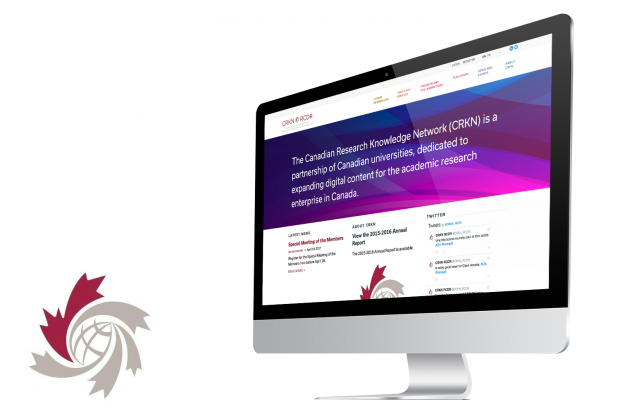 Support for Drupal 7 is ending on 5 January 2025—it’s time to migrate to Drupal 10! Learn about the many benefits of Drupal 10 and find migration tools in our resource center.
Support for Drupal 7 is ending on 5 January 2025—it’s time to migrate to Drupal 10! Learn about the many benefits of Drupal 10 and find migration tools in our resource center.The Canadian Research Knowledge Network is a partnership of universities that works with academic publishers to provide access to collections of digital content for the research community. Work is undertaken with a coordinated group of librarians, researchers, administrators and other stakeholders in the research community.
The Canadian Research Knowledge Network ("CRKN") negotiates rights and access to scholarly content to achieve its greatest possible impact and to support research, scholarships, creative activities and knowledge transfer. They have played a key role in building knowledge infrastructure while providing equitable and cost-effective access to information for universities Canada-wide.
Supported by additional funding from Library and Archives Canada (LAC), the CRKN spearheaded The Canadian National Digital Heritage Index (CNDHI) project. CNDHI (pronounced “Candy”) was designed to increase awareness, provide access to Canadian digital heritage collections, support academic research and facilitate information sharing.
The initial phase of work was completed in the first quarter of 2016. Its task was to index digitized heritage collections located at Canadian universities and, at provincial and territorial libraries. The index maps and aggregates the information for site visitors to easily filter and access those collections.

Objectives
As a partnership of 75 member universities, the CRKN has access to numerous collections of scholarly information including photographs, documents, virtual exhibits as well as other artefacts and images. With an initial database containing approximately 50 records, there was a need to enter and grow the number of records, and be able to organize and deliver them using a streamlined solution.
CRKHN site administrators needed to be able to enter the collections data from their Excel program into the Drupal 8, open source platform, both manually and in an automated manner. Recognized, standard fields needed to be utilized.
Website visitors needed a user-friendly, responsive interface to access the collections. The interface needed to be intuitive and have the capability of displaying records in a clear, concise manner that pushed the boundaries of library record design. Most important was the ability to effectively search the database while serving up the results in a meaningful and trusted way.
The solution needed to be intuitive and clear, using a powerful search mechanism that leveraged the taxonomies, keywords and content from the collection data.
Goals
- Develop the foundations of a search interface for a web-based collections hub that leverages technology to connect and serve researchers
- Increase engagement with CRKN by allowing site users to access the collections of participatory Canadian universities, archives and libraries
- Build a fully responsive website that works effortlessly on mobile, tablet, and desktop devices
- Provide auto importing of Excel-based records into Drupal 8 for launch
- Allow for manual importing of records for site administrators post-launch
- Create an accessible solution, to WCAG accessibility standards
- Provide intense and effective site-wide search capabilities that works effortlessly, even as the number of collections grow
- Use leading-edge technology with consideration for seamless future upgrades
- Use the newest release of Drupal (D8) to ensure the system has maximum longevity
- Provides full multilingual capabilities, initially in 2 national languages with potential to implement others
Solution
The work began by determining the content structure and by performing a data analysis with the client. CRKN understood the fields they wanted to use and by mapping the desired data structure to real collections, the final data structure was determined.
Drupal 8 was used to build the fully responsive search interface. Its backend data structure can be leveraged for other types of collections going forward and, the infrastructure and content structure are both reusable.
The design and user interface displays records in a clear, predictable, concise and search-friendly way. The responsive interface includes advanced search capabilities, English and French language interfaces, and the ability to make future enhancements as well as functional expansion.
Following the design and development phases, the initial data import that grew to approximately 100 collections, ranging in topic, institution and source, was completed. Post-launch support has included additional batch migrations as well as training to allow CRKN site administrators the ability to manually add collections as they become available.
Results
The initial phase of work was completed over a two-month period with approximately 100 collections imported. Four weeks later, over 700 collections were imported with continual additions occurring regularly. With positive feedback from librarians, academics and researchers, it is considered to be a valuable resource for the community and is growing in recognition.
Phase 2 of the project is being finalized. The Integrated Digital Scholarship Ecosystem (IDSE) will use the same interface and filters but will be projects-based. This new projects index will be similar in style to the CHNDI collections website but is envisioned to include data visualization, form development and subscription services while providing additional access to information.
During the testing phase of CNDHI, some minor Drupal 8 bugs were discovered – an expected discovery for a new version of the well-known content management system, but having little impact on the phase 1 deliverables. Being an Open Source platform, the issues were flagged and submitted to the Drupal community for fixes, ensuring the continual improvement of the platform in the days ahead.
Technical specifications
-